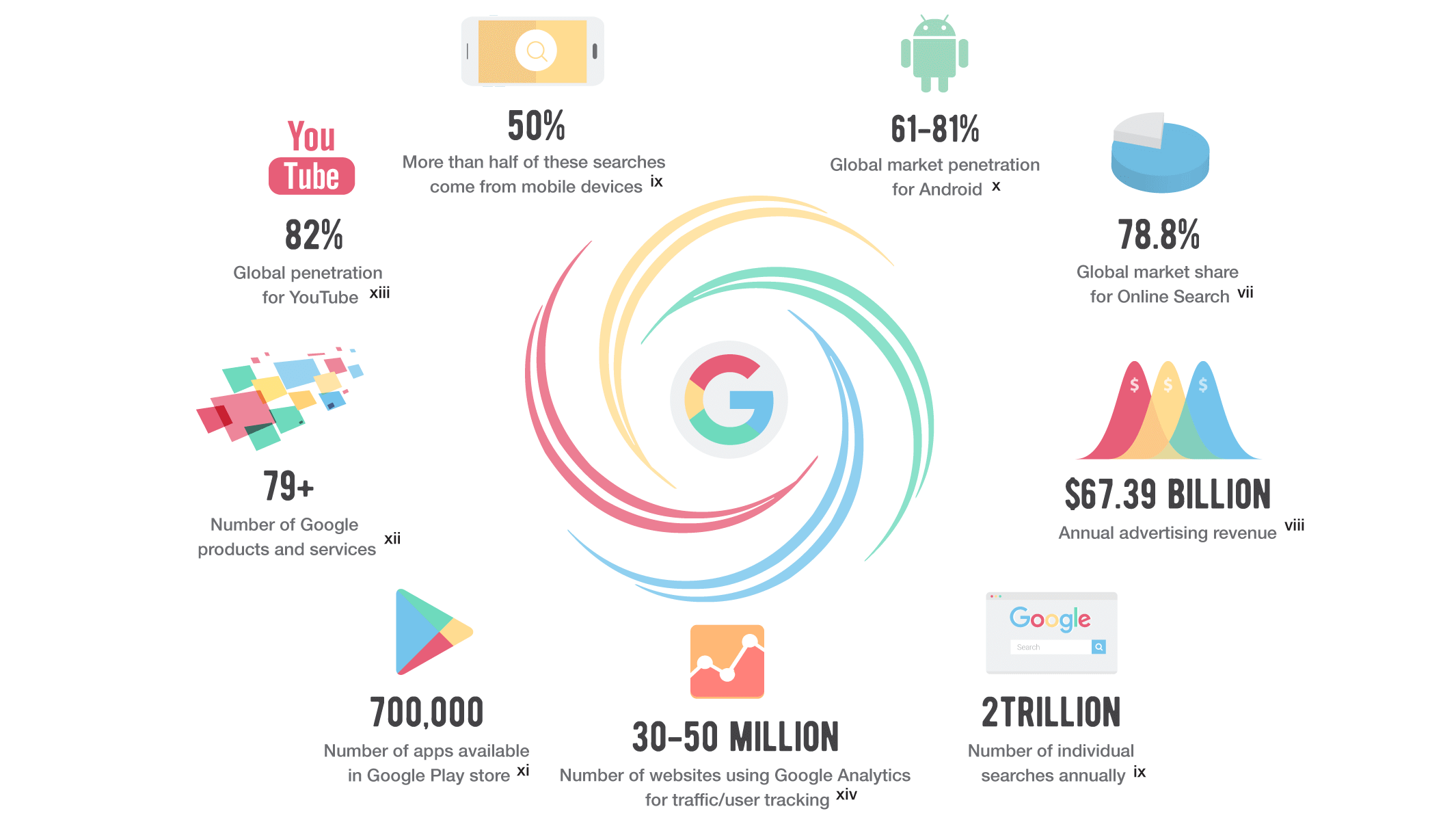Technology
How Google Tracks You – And What You Can Do About It

How Google Tracks You – And What You Can Do About It
Ever get the feeling you’re being watched?
It’s because you are – and for a rough proxy of this, use the browser extension Ghostery to see how many tracking scripts are watching you on a typical media site. (It doesn’t work for everything, but a large media site like Vice.com has 50+ trackers, with 40 of them focused on advertising).
Capturing this user data helps sites sell their inventory to advertisers, but a select few companies operate in this capacity at a whole different level. Google and Facebook are the best of examples of this, as nearly $0.60 of every dollar spent on digital advertising goes to them. They both have the sophistication and ubiquity to capture incredible amounts of information about you.
Google is Everywhere
Today’s infographic, which comes to us from Mylio, focuses in on Google in particular.
The search giant is massive in size, and there is a good chance you tap into Googleverse in some way:
- Global market penetration for Android is 61-81%.
- Google has a 78.8% market share for online search.
- The company generates $67.4 billion in annual ad revenue.
- Google processes two trillion searches annually.
- 30-50 million websites use Google Analytics to for tracking.
- There are 700,000 apps available in the Google Play store.
- 82% of videos watched online come from YouTube.
- In total, Google has at least 79 products and services.
According to Google’s documentation, it uses these services to pull out information on the “things you do”, “things you create”, and the things that make you unique.
See What Google Collects
All in all, Google tracks your activity history, location history, audio history, and device history. It also builds a profile for you for serving ads – age, gender, location, income, and other demographic data.
You can view and actually download this history by using a tool called Google Takeout.
Many people understand that their data helps support advertising revenues on websites they enjoy. Others are rightly concerned about their privacy, and how their information is used. Regardless of which category you fit in, becoming informed about how privacy on the internet works will help you craft an experience that best fits your preferences.
Technology
All of the Grants Given by the U.S. CHIPS Act
Intel, TSMC, and more have received billions in subsidies from the U.S. CHIPS Act in 2024.

All of the Grants Given by the U.S. CHIPS Act
This was originally posted on our Voronoi app. Download the app for free on iOS or Android and discover incredible data-driven charts from a variety of trusted sources.
This visualization shows which companies are receiving grants from the U.S. CHIPS Act, as of April 25, 2024. The CHIPS Act is a federal statute signed into law by President Joe Biden that authorizes $280 billion in new funding to boost domestic research and manufacturing of semiconductors.
The grant amounts visualized in this graphic are intended to accelerate the production of semiconductor fabrication plants (fabs) across the United States.
Data and Company Highlights
The figures we used to create this graphic were collected from a variety of public news sources. The Semiconductor Industry Association (SIA) also maintains a tracker for CHIPS Act recipients, though at the time of writing it does not have the latest details for Micron.
| Company | Federal Grant Amount | Anticipated Investment From Company |
|---|---|---|
| 🇺🇸 Intel | $8,500,000,000 | $100,000,000,000 |
| 🇹🇼 TSMC | $6,600,000,000 | $65,000,000,000 |
| 🇰🇷 Samsung | $6,400,000,000 | $45,000,000,000 |
| 🇺🇸 Micron | $6,100,000,000 | $50,000,000,000 |
| 🇺🇸 GlobalFoundries | $1,500,000,000 | $12,000,000,000 |
| 🇺🇸 Microchip | $162,000,000 | N/A |
| 🇬🇧 BAE Systems | $35,000,000 | N/A |
BAE Systems was not included in the graphic due to size limitations
Intel’s Massive Plans
Intel is receiving the largest share of the pie, with $8.5 billion in grants (plus an additional $11 billion in government loans). This grant accounts for 22% of the CHIPS Act’s total subsidies for chip production.
From Intel’s side, the company is expected to invest $100 billion to construct new fabs in Arizona and Ohio, while modernizing and/or expanding existing fabs in Oregon and New Mexico. Intel could also claim another $25 billion in credits through the U.S. Treasury Department’s Investment Tax Credit.
TSMC Expands its U.S. Presence
TSMC, the world’s largest semiconductor foundry company, is receiving a hefty $6.6 billion to construct a new chip plant with three fabs in Arizona. The Taiwanese chipmaker is expected to invest $65 billion into the project.
The plant’s first fab will be up and running in the first half of 2025, leveraging 4 nm (nanometer) technology. According to TrendForce, the other fabs will produce chips on more advanced 3 nm and 2 nm processes.
The Latest Grant Goes to Micron
Micron, the only U.S.-based manufacturer of memory chips, is set to receive $6.1 billion in grants to support its plans of investing $50 billion through 2030. This investment will be used to construct new fabs in Idaho and New York.
-

 Energy1 week ago
Energy1 week agoThe World’s Biggest Nuclear Energy Producers
-

 Money2 weeks ago
Money2 weeks agoWhich States Have the Highest Minimum Wage in America?
-

 Technology2 weeks ago
Technology2 weeks agoRanked: Semiconductor Companies by Industry Revenue Share
-

 Markets2 weeks ago
Markets2 weeks agoRanked: The World’s Top Flight Routes, by Revenue
-

 Countries2 weeks ago
Countries2 weeks agoPopulation Projections: The World’s 6 Largest Countries in 2075
-

 Markets2 weeks ago
Markets2 weeks agoThe Top 10 States by Real GDP Growth in 2023
-

 Demographics2 weeks ago
Demographics2 weeks agoThe Smallest Gender Wage Gaps in OECD Countries
-

 United States2 weeks ago
United States2 weeks agoWhere U.S. Inflation Hit the Hardest in March 2024














